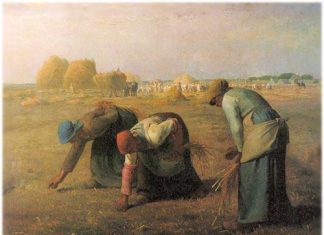| Issue #41 • September/October, 1996 |
Preserving produce by “pickling” is one of the oldest and most delightful ways to save your summer harvst for your winter table. The word “pickle” applies to any food preserved in brine and/ or vinegar, with or without bacterial fermentation, and with or without the addition of spices and sugar.
Foods pickled with vinegar are usually cooked before the vinegar is added. Because the food is cooked, no fermentation is required. This method is usually restricted to fruits, though some vegetables can be preserved in this way.
|
Foods pickled with salt are usually covered with a brine solution of the proper strength to allow fermentation to set in. The rate of fermentation is determined by the strength of the brine: the weaker the brine, the more rapidly fermentation takes place; the more concentrated the brine, the slower the fermentation. One recipe from an old-timer said to make a brine strong enough to float an egg (one pint of salt to one gallon of water) for her recipe for cucumber pickles.
Quick-process pickles, also called fresh-pack, use a salt-and-vinegar method that has a brief brining period before the vinegar is added. Sometimes fresh-packed pickles are canned in a spicy vinegar solution without brining. Whole cucumber dills and sweet gherkins are prepared by this method.
Helpful tips
Here are some helpful tips for making cucumber pickles:
- Use pure salt (99% sodium chloride) with no non-caking material or iodine added, for fermented pickles. Usually called “granulated salt,” “barrel salt,” or “meat curing salt,” it was once found at farm supply stores and speciality grocery stores, but now is available in most grocery stores in inexpensive 2½ lb. bags labeled “canning and pickling salt.” Regular non-iodized table salt can be used for quick-method pickles.
- The lime used for pickling is calcium hydroxide (air slaked or builder’s lime). You’ll find it beside the pickling salt in your grocery section with the canning jars and lids.
- Ground spices can darken pickles and relishes. Many recipes say to tie spices in a thin cloth bag and remove them before pickles are packed. Fresh spices give the best flavor. If dried herbs are used in substitution for fresh, use this ratio: 1 teaspoon dried = 1 tablespoon fresh. Spices and herbs lose their pungency in heat and humidity, so store them in airtight containers in a cool place.
Pickling spice, available at the grocery store, is made from ten to sixteen spices. Or you can make your own with the following recipe:
Pickling spice:
2 tablespoons mustard seed
1 tablespoon whole allspice
2 teaspoons coriander seeds
2 teaspoons cloves
1 teaspoon of ground ginger
1 teaspoon dried hot red pepper flakes
1 bay leaf, crumbled
a 2-inch cinnamon stick, crushed fine
In a bowl combine all the spices. Keep the mixture in a tightly sealed jar in a cool dark place for six months. Makes 1/3 of a cup.
- Dill is in season before cucumbers are ready for picking. Gather the dill, do not wash it, break heads off the stem and place heads in mason jars. Put on a cap and screw band tightly and freeze immediately.
- The vinegar used in pickling needs to be a 4 to 6% acetic acid, 40 to 60 grain strength. Check labels. Cider vinegar has a good flavor and aroma. Clear distilled vinegar is used for onion and cauliflower, because cider vinegar discolors, but for cucumber pickles this is not a problem. White distilled vinegar has a sharp, pungent acetic acid taste.

The right stuff for pickling: an unchipped crock, canning salt, vinegar, garlic, onion, sweet red peppers, fresh cucumbers, fresh dill, pickling spice, and jars and lids.Vinegar has been around a long time, pre-dating the Old Testament (which mentions Ruth dipping a bit of bread into vinegar). The name comes from vin aigre, which is French for “sour wine,” and that is where it began. The bacteria Acetobacter sours the wine, dissipates the alcohol, and leaves a mixture of 4% acetic acid and water. Roman legions put wine vinegar into their drinking water to purify it. Vinegar was a by-product of wine makers and brewers until the 17th century, when the French separated vinegar making it into a separate industry. The English make malt vinegar from sour beer and ale. Americans make vinegar out of fermented apple juice.
- Only fresh, firm, not-too-ripe cucumbers should be used for pickling. Do not use waxed cucumbers, since the brine cannot penetrate wax. Cucumbers should be small or medium-sized. No more than 24 hours should elapse between picking cucumbers and placing them in brine. (If my harvest isn’t adequate and I must buy more produce, I get the process set up before I go to the farmers’ market to hunt for the right fruit, taking the farmer at his word that the cucumbers were harvested that morning.) Wash to remove dirt, blossom, and grit. Once in the brine, keep the cucumbers in a cool place; about 70° F is best. The fermentation process takes anywhere from a few days to several weeks, and is complete when bubbles stop coming up to the top of the container. Test for bubbles by tapping container on the side with your hand. Cut a cucumber: if it is the same color throughout and has no noticeable rings, fermentation is complete.
- Hard water (that is, water with extra calcium salts) interferes with the brining process. Purchase bottled water, or add ½ cup vinegar to a gallon of hard water.
- For the brining process, use stone jars or crocks, unchipped enamelware, or glass containers. Cover with a heavy plate or glass lid while brining. Use a filled jar of water to hold the cover down, so that vegetables are kept below the surface of brine. Pickles are soft and slippery if they’re exposed above the brine or if the brine is too weak. Slippery stuff also results from storing in too warm a place, or cooking too long or a too-high temperature when cooking.
When heating pickling liquids, use glass, unchipped enamelware, stainless steel, or aluminum utensils. Don’t use copper, brass, galvanized, or iron utensils, as these metals will react with acids or salts and cause undesirable color changes in the pickles or form compounds which could be poisonous. Be attentive when timing the processing procedure. For fermented cucumbers and fresh-pack dills, start to count processing time as soon as the filled jars are placed in the boiling water. This keeps them from tasting cooked and loosing their crispness.
To sterilize jars and glasses for pickling: Wash the jars in hot suds and rinse them in scalding water. Put the jars in a kettle and cover them with hot water. Bring the water to a boil, cover, and boil the jars 15 minutes from the time that steam emerges from the kettle. Turn off the heat and let the jars stand in the hot water. Just before they are to be filled, invert the jars onto a dish towel to dry. The jars should be filled while they are still hot. Sterilize the jar lids for five minutes, or according to manufacturer’s instructions.
Frightened? Don’t be. Cucumber pickles are successfully produced in ordinary kitchens every year. I stick to the simple, quick methods for most of my canning, enjoying the special tastes that cannot be purchased at the grocery store. My one exception to the “quick and easy” is a favorite recipe for dills:
Fermented dill pickles
50 to 60 smooth small cucumbers
1 ounce whole mixed spices
dill
1 pound pure salt
1 gallon water
1 pint cider vinegar
Place a layer of dill in the bottom of a clean, four-gallon crock. Add ½ ounce whole mixed spices. Pack cucumbers to within three inches of top of crock. Then add another ½ ounce whole mixed spices and a layer of dill.
Make a cold brine of the salt, water, and vinegar. Pour brine over cucumbers. Cover with a china plate. Weight plate down to keep cucumbers below surface of brine. Cover top of crock with cloth.
Remove any scum that forms on surface of liquid.
Just as soon as bubbling ceases and active fermentation stops, place pickles in standard canning jars. Pour brine over pickles, screw on lids firmly tight, and immerse in a kettle of tap-temperature water. Bring to a boil and boil for 15 minutes. When jars are cooling, you can tell when each one vacuum-seals, because the lid will click down into a little indentation. Store in a cool, dry, dark place.
A variation of this fermented pickle is this mustard recipe:
Fermented mustard pickles
50 to 60 smooth small cucumbers
1 gallon vinegar
½ pound (16 tablespoons) dry mustard
1 cup salt
Wash cucumbers, pack into sterilized jars. Work the mustard into a paste using a little of the vinegar, then dissolve it in the rest of the vinegar. Pour cold solution over cucumbers to within a half inch of the jar top. Put on the cap, and screw the band firmly tight. When fermentation (bubbling) has stopped, process in boiling water bath 15 minutes. Makes three gallons. I prefer this method because the fermented pickles are not moved into another container after the fermenting process.
There are many different kinds of pickles. Here are recipes for some of my favorites:
Fresh kosher style dill pickles
Kosher pickles are made in accordance with Jewish dietary laws. All ingredients are derived from vegetable matter only, and utensils used in the processing have not been in contact with meat products. I noticed the presence of garlic in all of my kosher cucumber pickle recipes. This is my favorite:
|
30 to 36 cucumbers (3-4 inches long)
3 cups vinegar
3 cups water
6 tablespoons salt
fresh or dried dill
½ to 1 clove garlic, sliced
½ teaspoon mustard seed
Wash cucumbers. Make a brine of the vinegar, water, and salt. Bring to a boil. Place a generous layer of dill, garlic, and mustard seed in the bottom of six pint jars. Pack the cucumbers in the jars. Fill the jars to within a half inch of the top with the boiling brine. Put lids on jars, screw bands firmly tight. Process 20 minutes in boiling water bath. Pickles will shrivel after processing, but will plump up in the sealed jars, so don’t panic and open the jars. Yields six pints.
Bread-n-butter pickles
Bread-n-butter pickles are a delicious condiment that adds sparkle to sandwich meats and blackeyed peas. My young children mound bread-n-butter pickles on top of lima beans, and even ask for a second helping.
16 cups of cucumber, sliced ¼ inch thick (4 pounds)
6 cups of thinly sliced onions
½ cup salt
5 cups sugar
5 cups cider vinegar
1-½ teaspoons turmeric
1-½ teaspoons celery seed
1-½ teaspoons mustard seed
In a large (seven-quart) kettle, mix cucumbers, onions and salt. Cover with cold water and three trays of ice cubes. Let stand three hours. Drain, rinse well, and drain again. Set aside. In another large kettle, mix sugar and remaining ingredients. Over high heat, heat to boiling. Reduce heat and simmer uncovered 30 minutes, or until syrupy, stirring often. Get jars ready (wash and have hot), add cucumbers and onions to syrup over high heat, heat almost to boiling, stirring some, but don’t boil. Ladle hot mixture into hot jars. Leave 1/2″ head space. Wipe jar tops, put on rings and lids and process in boiling water 15 minutes. Cool. Makes six pints. For a Christmas variation, add two cups of sliced red sweet peppers.
Sweet gherkins
A gherkin is a variety of cucumber that bears small prickly fruit. The name also refers to the immature fruit of the common cucumber when pickled.
Use cucumbers no larger than two inches in length. Leave ¼ inch or more of the stem on each. Wash and place in a crock. Add salt, using one cup of salt for each gallon of cucumbers. Pour boiling water over them and let them stand 24 to 36 hours. Remove the pickles from the brine and drop them into a solution of equal parts vinegar and water. Heat to the boiling point and remove pickles to sterilized jars. Add a teaspoon of mixed pickling spices to each quart, and also a fairly long strip of horseradish root. Add a cup of sugar per quart to the hot vinegar and water, and pour it over the pickles. Water bath 10 minutes.
Icicle pickles
“Icicle” pickle refers to the shape of the cucumber pieces, a lengthwise cut resulting in long slivers shaped like icicles. Cucumbers cut in this fashion can be dilled, sweetened, or fermented.
celery
pickling onions
1 quart cider vinegar
1/3 cup pickling salt
1 cup sugar
Cut large cucumbers into four to eight pieces lengthwise. Let stand in ice water eight hours or overnight. Pack into hot sterilized jars.
Fill the center of each jar with two pieces of celery and six pickling onions. Combine the vinegar, salt, and sugar. Heat to a boil. Fill jars and seal in water bath 10 minutes.
This is the basic recipe, and you make as much vinegar/sugar/salt solution as you need. I save unused portions in the refrigerator for the next day’s pickles during canning season, or pour it over sliced cucumber, green bell pepper, and onion for a salad. The salad is best when chilled a few hours.
Start a collection of pickle recipes. Commercial canning jar companies produce recipe books with lots of tips.

















